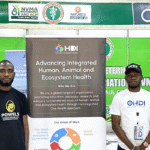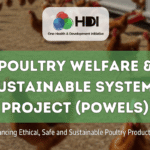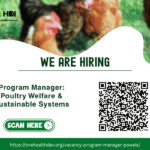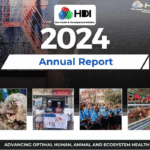The Menace of Antimicrobial Resistance: The Pivotal Role of Veterinarians
Imagine a bustling city filled with superheroes. Each one has a special power to fight off villains and keep us healthy. But there’s a problem, some villains (germs) are sneaky and have learned how to resist the powers of our superheroes (antimicrobials). This is what we call Antimicrobial Resistance (AMR).
Antimicrobials are substances that are capable of killing or inhibiting the growth of microorganisms, which include bacteria, viruses, fungi, and parasites. Antibiotics are a type of antimicrobial specifically designed to combat bacterial infections, while antivirals target viruses, antifungals tackle fungi, and antiparasitics combat parasites. In the context of this essay, bacteria, viruses, fungi, and parasites are the troublemakers.
Now, you might be wondering, “Why should I care about these tiny troublemakers?” Well, buckle up, because I am about to tell you why AMR is a big deal and how WE can be superheroes in this fight!
The Devastating Deeds of AMR
It is no news that AMR is a looming danger in Nigeria and the world at large. The WHO has declared it as one of the top 10 global public health threats confronting humanity. Globally, an estimated 4 million deaths were associated with drug-resistant infections (directly and indirectly), with 1.3 million of these deaths directly attributable to drug resistance [1]. The highest death rates occurred in sub-Saharan Africa, with 255,000 deaths recorded as attributable to resistant bacterial infections, second only to Asia and Western sub-Saharan Africa, accounting for 27 out of 100,000 persons that died directly from hard-to-treat infections compared to 16 deaths per 100,000 persons globally [2]. Devastating!
Antimicrobial misuse in livestock contributes to the development of antimicrobial resistance [3]. Also, data on the prevalence of AMR among animals and humans in Nigeria is poor due to the inconsistency and lack of proper record keeping of antimicrobial use by the general public. The AMR crisis in Nigeria has been exacerbated by several contributing factors.
Contributing factors/ challenges
Firstly, the availability of over-the-counter antimicrobials is a significant concern. The ease with which an individual can obtain antimicrobials without a prescription contributes to misuse and overuse, fostering the development of resistant strains of microbes. Farmers and pet owners have unrestricted access to antimicrobials. This practice not only poses a direct threat to individual health but also fuels the broader issue of antimicrobial resistance in the community.
Secondly, the lack of awareness and education plays a pivotal role. Many individuals are uninformed about the appropriate use of antimicrobials, especially antibiotics, leading to non-compliance with dosage regimens and premature discontinuation of treatment. The existence of language barriers further compounds this issue, hindering effective communication between healthcare providers and patients. This ‘multilingual divide’ impedes the dissemination of crucial information on proper antimicrobial usage and the risks associated with misuse.
Lastly, inadequate healthcare infrastructure exacerbates the problem. Insufficient resources and personnel in healthcare settings contribute to sub-optimal patient care, making it challenging to implement rigorous antimicrobial stewardship programs and monitor prescription practices.
Having stated the challenges surrounding AMR, it is imperative to shift our focus towards finding viable solutions that can address these issues at their core. This essay will be addressing some of these issues by proffering solutions that can be and should be executed by veterinarians in curbing AMR.
In Nigeria, veterinarians play a major role in curbing the threats of AMR through a comprehensive approach that encompasses education, outreach, research, and advocacy. The following are veterinarian’s key role in implementing innovative solutions to combat AMR in Nigeria:
Innovative solutions
- Education and Advocacy: Let them know, then spread the message!
Education becomes a powerful tool in the hands of veterinarians as they extend their outreach beyond the confines of veterinary clinics. Workshops on AMR are conducted in diverse settings, including schools, workplaces, religious centers, and social hubs. Addressing not only science professionals but also non-science individuals, emphasizes the importance of “hand hygiene” after coming in contact with pets or livestocks, surroundings and also the critical role of prevention in mitigating AMR.
Veterinarians should champion the integration of AMR awareness into school curricula, particularly for children owning pets. By imparting knowledge on responsible antimicrobial use in veterinary medicine, veterinarians contribute to raising a generation of informed pet owners who understand the implications of AMR.
Furthermore, there should be promotion of multilingual awareness programs, recognizing the diversity of the population/audience. Being a volunteer for an AMR outreach carried out during this year’s World AMR Awareness Week at an abattoir on the 23rd November, 2023. I had a first-hand experience of the challenges in disseminating information and educating an ethnically diverse community of people involved in livestock rearing and meat selling on AMR, this made me resonate with the problem of language barrier. Through the effort of making AMR messages available in various languages, especially targeting the elderly and educationally less privileged population, veterinarians can ensure that critical information transcends language barriers, reaching a wider audience.
- Extension to the less priviledged
There are several underserved regions (especially rural areas) when it comes to veterinary services. For instance where I live in Etche village, Rivers state,there used to be only one veterinary clinic in the whole of the village, which was not efficient in carrying out veterinary service, in fact I later discovered it was not run by a veterinarian.
Identifying key rural regions where major agricultural activities takes place with little or no access to veterinarians or veterinary services. These regions should be provided with facilities that allow access to health-care and establishment of mobile/ambulatory services for farmers or stationing veterinarians equipped with diagnostic tools in these regions. This direct outreach ensures that veterinary expertise is brought to the heart of agricultural communities, where the impact of AMR is most often pronounced.
- Research and Development
Development of rapid diagnostic tools and techniques to enhance antimicrobial susceptibility testing is paramount to curbing the inappropriate use of antimicrobials and ensure targeted therapy. The result from these tools should be fast yielding and cheap to carry out.
Also, engagement in collaborative research with interdisciplinary teams to explore and design novel antimicrobials derived from plants is a feasible solution that could be explored by veterinarians. The knowledge of veterinary medicine will contribute to the development of alternative treatments, hence diversifying options beyond conventional antimicrobials.
- Enforcement of Antimicrobial Stewardship
Veterinarians should advocate for responsible antimicrobial use by championing the implementation of Antimicrobial Susceptibility Testing (AST) as a vital part of diagnosis. AST results should be presented at the point of antimicrobial purchase to a certified pharmacist. This initiative will not only promotes judicious antimicrobials use but also underscores the veterinarian’s expertise in guiding proper medication selection for the animal’s health.
In addition, there should be the appointment of officials by the veterinary governing body dedicated to client follow-ups. This will enhance client’s engagement and adherence to treatment plans. This would ensure ongoing communication with pet owners/farmers, addressing concerns related to the health status of animals under their care.
Furthermore, advocacy for the establishment of certified veterinary pharmacies, collaborating with regulatory bodies to ensure that antimicrobials are distributed under veterinary supervision. These measure minimizes misuse and promotes responsible antimicrobial use.
Ultimately, addressing these multifaceted challenges while bearing in mind the One Health initiative demands comprehensive strategies that include educational campaigns, improvements in healthcare infrastructure and collaborations, and regulatory measures to effectively curb the threats of AMR in the future.
References
- Murray, C. J. (2022). Global Burden of Bacterial Antimicrobial Resistance in 2019: A Systematic Analysis. The Lancet, 399(10325), 629–655. https://doi.org/10.1016/S0140-6736(21)02724-0
- Nigeria health watch (2022), https://articles.nigeriahealthwatch.com/the-true-burden-of-antimicrobial-resistance-ne w-study-has-major-implications-for-nigeria/
- Alhaji, N.B., & Isola, T.O. (2018). Antimicrobial usage by pastoralists in food animals in North-central Nigeria: The associated socio-cultural drivers for antimicrobials misuse and public health implications. One Health, 6, 41 – 47.











